Book contents
- Frontmatter
- Contents
- Preface
- 1 Diagnosing depression
- 2 Traumatic life events: general issues
- 3 Life events and depression: preliminary issues
- 4 Life events and depression: is there a causal connection?
- 5 Genetics of depression
- 6 Gene–environment correlation and interaction in depression
- 7 Monoamines and depression
- 8 Stress hormones and depression
- 9 Stress, the brain and depression
- Epilogue
- Name index
- Subject index
8 - Stress hormones and depression
Published online by Cambridge University Press: 15 October 2009
- Frontmatter
- Contents
- Preface
- 1 Diagnosing depression
- 2 Traumatic life events: general issues
- 3 Life events and depression: preliminary issues
- 4 Life events and depression: is there a causal connection?
- 5 Genetics of depression
- 6 Gene–environment correlation and interaction in depression
- 7 Monoamines and depression
- 8 Stress hormones and depression
- 9 Stress, the brain and depression
- Epilogue
- Name index
- Subject index
Summary
Stress and stress response
Human beings, like any other living organism, strive towards a state of dynamic equilibrium, the regulation of a setpoint, called homeostasis. The continuance of this state can be threatened by a variety of variables originating from within or without, biological or psychological in nature. Psychological stimuli or stressors are evaluated as to their destabilizing potential. Dependent on the outcome of the appraisal the organism will marshall a set of adaptive responses to maintain or re-establish equilibrium. They are partly biological, partly behavioural in nature, and collectively named the stress-response, or in short stress. The latter term, thus, refers to the state evoked by the stressor. The limbic brain, e.g. hippocampus, amygdala and frontal cortex serve as an interface between the appraisal process and the appropriate biological and psychological responses to the incoming information.
The physiological components of the stress response are geared towards activation of functions needed for survival. For instance, the availability of energy increases through enhancement of gluconeogenesis, protein catabolism and lipolysis. Oxygen supply is stepped up by increasing respiratory rate, heart rate and blood pressure. Functions not of immediate survival value, such as digestive functions, appetite, growth, reproductive behaviour and immune functions are downregulated. On the behavioural level, alertness, vigilance, focused attention and cognition surge.
- Type
- Chapter
- Information
- Stress, the Brain and Depression , pp. 144 - 224Publisher: Cambridge University PressPrint publication year: 2004
- 1
- Cited by



